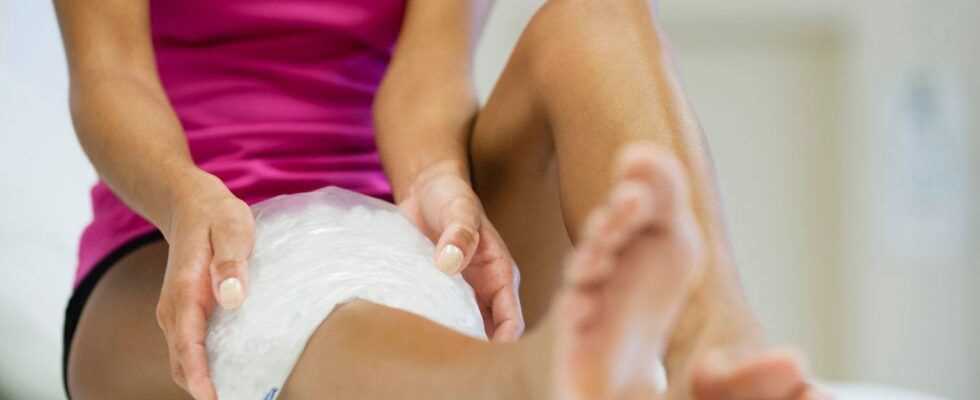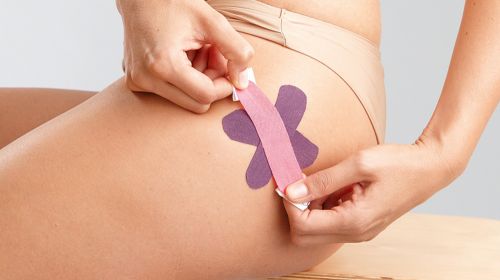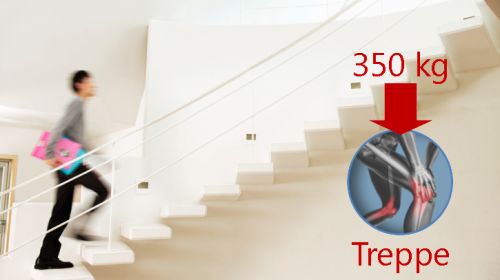It happens quickly, especially when doing sports: one push or one fall is enough and the knee is swollen and sore. Here you can find out what you need to know in the event of a bruise and which immediate measures can help.
- Contusion: According to the PECH rule, knee injuries caused by an accident during sports should be cooled immediately.
- © PhotoAlto / Odilon Dimier / PhotoAlto Agency RF Collections via gettyimages
A bruise (also contusion) is caused by blunt, direct violence, such as a collision during sports or a fall at home. It is a closed injury – the skin usually remains intact in the event of a bruise. The affected area is sensitive to pressure and strain and swelling can occur. If a joint is affected, as is the common case of a knee bruise, freedom of movement may be temporarily restricted.
Article content at a glance:
How does a bruise develop?
The external force impacts the tissue, such as subcutaneous fat, muscles and connective tissue. Blood and tissue fluids can seep in and swelling of the surrounding tissue occurs. Bruises (hematomas) are also possible. Usually bruises heal within a few days. In severe cases, however, it may take longer to heal until the patient is completely free of pain.
If the bruise is deeper, it may be that no change is externally visible, but organs, muscles or joints can still be injured. Any part of the body can be affected by a bruise, including internal organs. If, for example, a kidney contusion occurs, this can be very painful for those affected.
Doctors differentiate according to the severity of the contusion:
- Bruise without tissue damage: slight redness and swelling, usually heals quickly
- Contusion with tissue damage: severe swelling, with bruises (hematoma) and severe pain, longer healing process, sometimes even permanent damage without medical treatment
A doctor should be consulted, especially if the eyeball is bruised, as the temporary increase in intraocular pressure can lead to permanent damage, such as a detached retina.
Where can a bruise occur?
A bruise can occur anywhere on the body and in principle any tissue can be bruised. So not only soft tissue such as skin, adipose tissue, muscles and tendons, but also joints, bones and organs. Even the eye or brain can be bruised when blunt force is applied.
At a Bruised bone (Bone Bruise), there is an accumulation of fluid in the bone or bleeding between the bone and periosteum as a result of external violence. Bruised bones are very painful and can take a long time to heal. Traumatic bone edema usually heals completely within six months. Microfractures are also possible in the context of a bone contusion, i.e. the smallest damage to the bone tissue. This form of bruise can also result from constant overload, as is the case with extreme athletes, for example.
Particularly exposed areas like arms and legs are prone to one Joint contusionin which fluid accumulates in the joint as a result of blunt trauma (joint effusion). Bleeding and hematoma formation in the joint cavity is also possible. A joint contusion is painful and there is restricted mobility, primarily due to fluid in the joint and secondarily due to pain when moving.
At a Muscle contusion there is a hematoma between the muscle fibers. What is very painful at first, usually heals quickly. In the case of a very severe bruise, complications such as the compartment syndrome can also occur: If a lot of fluid seeps into the muscle tissue, the pressure on the tissue can increase so that nerves and blood vessels are squeezed, which can cause irreparable damage to the muscle as it is no longer adequately supplied becomes.
The symptoms of this urgent treatment complication after a bruise are:
- Violent pain
- Feeling of tension or pressure in the affected region
- Severe swelling
- Sensory disturbances such as tingling, numbness, paralysis
If symptoms occur after an injury, a doctor should be consulted immediately: it is an acute emergency.
These parts of the body are particularly often affected
Bruises result from a blunt trauma such as a blow or a fall. This is why bruises are particularly common during sports or as a result of an accident.
Bruise on the knee: The knee joint is particularly often affected by a bruise. The painful injury usually results in restricted mobility, and the ability to bend and stretch the affected leg is reduced. If the knee is only bruised and no ligaments or bones are injured, the bruise in the knee usually heals quickly, although it is advisable to take care of yourself. Exercise should be avoided as long as the knee is painful to prevent subsequent inflammation.
Contusion on the tailbone: If you fall back in an unfavorable way, such as in an accident in the slippery shower or while inline skating, this painful bruise can develop on the lower back. If the tailbone is bruised, every movement usually hurts, sitting and lying down is difficult. An orthopedic seat cushion can provide relief when sitting.
Thigh contusion: This type of muscle contusion is also known as a horse kiss and is often caused by collision during a team sport such as soccer. A muscle bruise like this usually heals without any problems. However, if the pain persists for a long time or if it gets worse and the bruise does not recede or if it is particularly severe, medical advice should be sought.
Bruise: first aid for sports injury
In many sports you can wear protective clothing, which can reduce the risk of bruises. If you have suffered a blunt trauma, immediate measures according to the PECH rule help. They aim to contain the leakage of fluid into the surrounding tissue and prevent excessive swelling.
PECH: First aid for a bruise
PAuse: After an injury, the activity that caused it should be interrupted. The bruise should be immobilized and physical exertion should be avoided, otherwise the blood vessels will dilate. Swelling is promoted by exertion.
E.is: Blood vessels contract when it is cold, which means that less blood can seep into the tissue. The bruise should be cooled immediately after it appears. Attention: Never put an ice pack directly on the skin as it can cause cold burns. Better to wrap a scarf or towel around it and then place it on the skin.
C.Compression: A compression bandage helps – the pressure is supposed to prevent swelling, as fluid cannot so easily seep into the surrounding tissue. The pressure bandage should fit tightly, but never tighten.
Hhitting: If the affected area is raised, gravity counteracts swelling and less blood flows into the bruised area of the body.
These four points can usually prevent worse immediately after the bruise. Those who experience severe pain during the healing process can take a pain reliever. Arnica ointment can also have a supportive effect after a bruise. Cooling quark compresses are recommended as a home remedy for a bruise.
When to see a doctor with the bruise?
In the case of a slight bruise with moderate pain, there is usually no need to consult a doctor, the bruise will quickly go away on its own. If a bruised joint does not heal by itself, and if the pressure in the joint is too high, medical intervention may be required to remove the fluid from the joint.
Is the pain and swelling severe, or is the injury in a particularly dangerous place, like?
- on the head,
- in the eyes
- in the face,
- in the abdomen or
- on the ribs,
medical advice should be sought in order to be able to act in a targeted manner.


